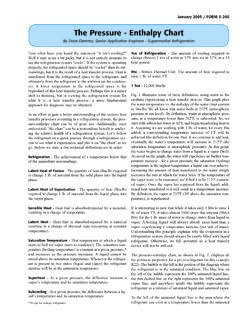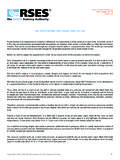Transcription of Generalized Compressibility Chart
1 Generalized Compressibility Chart v The p- -T relation for 10 common gases is shown in the Generalized Compressibility Chart . 1 Dr. J. Ortega - Spring 2014 Generalized Compressibility Chart TRpZv In this Chart , the Compressibility factor, Z, is plotted versus the reduced pressure , pR, and reduced temperature TR, where pR = p/pc TR = T/Tc (Eq. ) (Eq. ) (Eq. ) The symbols pc and Tc denote the temperature and pressure at the critical point for the particular gas under consideration. These values are obtained from Tables A-1 and A-1E. kJ/kmol K Btu/lbmol oR 1545 ft lbf/lbmol oR (Eq. ) is the universal gas constant R2 Generalized Compressibility Chart When p, pc, T, Tc, v , and are used in consistent units, Z, pR, and TR are numerical values without units. Example: For air at 200 K, 132 bar, TR = 200 K/133 K = , pR = 132 bar = where Tc and pc for air are from Table A-1.
2 With these TR, pR values, the Generalized Compressibility Chart gives Z = R With v = Mv, an alternative form of the Compressibility factor is Z = pv RT (Eq. ) where R = R M (Eq. ) 3 Dr. J. Ortega - Spring 2014 4 Dr. J. Ortega - Spring 2014 5 6 Dr. J. Ortega - Spring 2014 7 Dr. J. Ortega - Spring 2014 Studying the Generalized Compressibility Chart The solid lines labeled with TR values represent best fits to experimental data. For the 10 different gases represented there is little scatter in data about these lines. At the lowest reduced temperature value shown, TR = , the Compressibility factor varies between and Less variation is observed as TR takes higher values. 8 Dr. J. Ortega - Spring 2014 Studying the Generalized Compressibility Chart For each specified value of TR, the Compressibility factor approaches a value of as pR approaches zero.
3 9 Dr. J. Ortega - Spring 2014 Introducing the Ideal Gas Model To recap, the Generalized Compressibility Chart shows that at states where the pressure p is small relative to the critical pressure pc (where pR is small), the Compressibility factor Z is approximately 1. At such states, it can be assumed with reasonable accuracy that Z = 1. Then pv = RT (Eq. ) 10 Dr. J. Ortega - Spring 2014 Introducing the Ideal Gas Model Three alternative forms of Eq. can be derived as follows: With v = V/m, Eq. gives pV = mRT (Eq. ) With v = v/M and R = R/M, Eq. gives (Eq. ) TRp v Finally, with v = V/n, Eq. gives pV = nRT (Eq. ) 11 Dr. J. Ortega - Spring 2014 12 Dr. J. Ortega - Spring 2014 Introducing the Ideal Gas Model Investigation of gas behavior at states where Eqs. are applicable indicates that the specific internal energy depends primarily on temperature.
4 Accordingly, at such states, it can be assumed with reasonable accuracy that it depends on temperature alone: u = u(T) (Eq. ) With Eqs. and , the specific enthalpy also depends on temperature alone at such states: h = u + pv = u(T) + RT (Eq. ) Collecting results, a gas modeled as an ideal gas adheres to Eqs. and Eqs. and 13 Dr. J. Ortega - Spring 2014 Specific Heats Three properties related to specific internal energy and specific enthalpy having important applications are the specific heats cv and cp and the specific heat ratio k. vv Tuc(Eq. ) ppThc (Eq. ) vcckp (Eq. ) In general, cv is a function of v and T (or p and T), and cp depends on both p and T (or v and T). Specific heat data are provided in Fig and Tables A-19 through A-21. Although cv and cp are referred to as specific heats, there is no general relationship between them and the heat transfer term of the energy balance denoted by Q.
5 14 Dr. J. Ortega - Spring 2014 Internal Energy and Enthalpy of Ideal Gases For a gas obeying the ideal gas model, specific internal energy depends only on temperature. Hence, the specific heat cv, defined by Eq. , is also a function of temperature alone. That is, (Eq. ) dTduTc )(v(ideal gas) On integration, (Eq. ) dTTcTuTu )(12vT1 T2 (ideal gas) 15 Dr. J. Ortega - Spring 2014 Internal Energy and Enthalpy of Ideal Gases Similarly, for a gas obeying the ideal gas model, specific enthalpy depends only on temperature. Hence, the specific heat cp, defined by Eq. , is also a function of temperature alone. That is, (Eq. ) dTdhTcp )((ideal gas) On integration, (Eq. ) dTTcThThp )(12T1 T2 (ideal gas) 16 Dr. J. Ortega - Spring 2014 Internal Energy and Enthalpy of Ideal Gases In applications where the specific heats are modeled as constant, For several common gases, evaluation of changes in specific internal energy and enthalpy is facilitated by use of the ideal gas tables: Tables A-22 and A-23.
6 Table A-22 applies to air modeled as an ideal gas. (Eq. ) (Eq. ) u(T2) u(T1) = cv[T2 T1] h(T2) h(T1) = cp[T2 T1] 17 Dr. J. Ortega - Spring 2014 18 Dr. J. Ortega - Spring 2014 TABLE A-22 Ideal Gas Properties of Air T(K), h and u(kJ/kg), so (kJ/kg K) when s = 0 when s = 0 T h u so pr vr T h u so pr vr 250 979. 1400 260 1420 270 1440 280 1460 285 1480 290 1500 295 1520 300 1540 305 1560 310 1580 Internal Energy and Enthalpy of Ideal Gases Example: Using Table A-22, determine the change in specific enthalpy, in kJ/kg, for a process of air from an initial state where T1 = 300 K, p1 = 1 bar to a final state where T2 = 1500 K, p2 = 10 bar.
7 Solution: h1 = kJ/kg; h2 = kJ/kg h2 h1 = kJ/kg 19 Property Data Use in the Closed System Energy Balance Example: A closed, rigid tank consists of 1 kg of air at 300 K. The air is heated until its temperature becomes 1500 K. Neglecting changes in kinetic energy and potential energy and modeling air as an ideal gas, determine the heat transfer, in kJ, during the process of the air. 1 kg of air Q T1 = 300 K T2 = 1500 K State 1 State 2 2 T v T1 = 300 K 1 T2 = 1500 K p2 p1 20 Dr. J. Ortega - Spring 2014 Property Data Use in the Closed System Energy Balance Solution: An energy balance for the closed system is KE + PE + U = Q W 0 0 0 where the kinetic and potential energy changes are neglected and W = 0 because there is no work mode. Thus Q = m(u2 u1) TABLE A-22 Ideal Gas Properties of Air T(K), h and u(kJ/kg), so (kJ/kg K) when s = 0 when s = 0 T h u so pr vr T h u so pr vr 250 979.
8 1400 260 1420 270 1440 280 1460 285 1480 290 1500 295 1520 300 1540 305 1560 310 1580 Q = (1 kg)( ) kJ/kg = kJ Substituting values for specific internal energy from Table A-22 21 22 Dr. J. Ortega - Spring 2014 23 Dr. J. Ortega - Spring 2014 24 Dr. J. Ortega - Spring 2014 25 Dr. J. Ortega - Spring 2014 (Eq. ) Polytropic Process A polytropic process is a quasiequilibrium process described by pV n = constant 26 Dr. J. Ortega - Spring 2014 27 The exponent, n, may take on any value from to + depending on the particular process. For any gas (or liquid), when n = 0, the process is a constant- pressure (isobaric) process.
9 For a gas modeled as an ideal gas, when n = 1, the process is a constant-temperature (isothermal) process. ( ) ( ) Dr. J. Ortega - Spring 2014 28 When the ideal gas equation of state is introduced into the previous equations, the following expressions are obtained respectively. For a gas modeled as an ideal gas, when n = 1, the process is a constant-temperature (isothermal) process. 29 Dr. J. Ortega - Spring 2014 30 Dr. J. Ortega - Spring 2014 31





